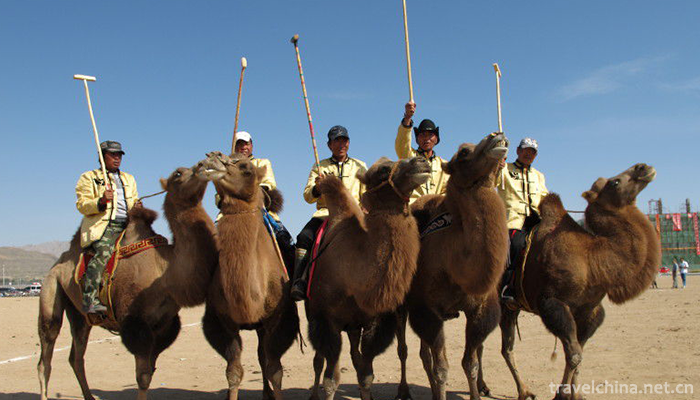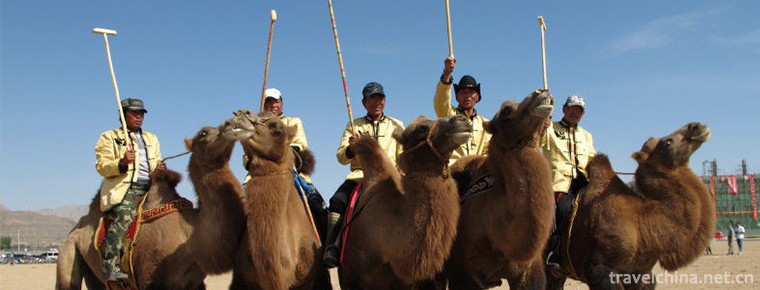Mongolian camel raising custom
Mongolian camel raising custom
The Mongolian camel-raising custom has a long history. In the practice of production and life with a long history, camel has become the most loyal partner of mankind while making outstanding contributions to mankind. In view of the contribution of camels to human beings, nomads in barbaric times regarded camels as God-given objects, and the image of camels for worship can be traced back to Shun. It is an important source of Alxa spirit and ideal, an important resource for the construction of Alxa League, and an important part of China's cultural heritage.
On June 7, 2008, the Mongolian camel-raising custom was approved by the State Council and listed in the second batch of national intangible cultural heritage list.
Folk activities
Camel racing
Mongolian camel racing is one of the traditional sports of Mongolian, and it is an important part of the cultural heritage of camel inherited from history. According to the investigation and research, camel racing came into being after it was domesticated and used in production, life and military affairs.
The nomadic people in northern China began to domesticate camels as early as 5000 years ago. The Book of Mountains and Seas, Beishan Classic, records: "Its animals are many camels, with saddles, know where the water springs are, do good in quicksand, travel 300 miles a day, and bear a thousand kilograms." The biography of the Huns in Historical Records records that during the period of "over Tangyu", the Rong people (Shanrong, Yao, Qiu Cong) living in Xinjiang, Mongolia (including Inner Mongolia and Outer Mongolia) and Central Asia (called Xiongnu in Qin and Han Dynasties) domesticated the wild "camel" as a "fantastic animal" and "moved along with horses, cattle and sheep".
With the development of history, camels have been domesticated and used in production, life and military. The Chinese camel culture has a long history.
The Mongolians living in the desert Gobi were the earliest people to tame and use camels. They not only used camels in production and life, but also introduced camels into competitive competitions, forming a traditional sport - Mongolian camel racing. At first, camels were mainly used for carrying, while camel racing was integrated into the chasing game of visiting relatives and friends. Later, the Mongolian people started camel racing when they offered sacrifices to Aobao, held temple fairs and held group activities such as Nadam Mu, and gradually formed a scale, which continued.
Camel ball
Brief introduction of camel ball
Camel sport originates from polo. There are two matches in a game. A team has six players in each game. The time of each game varies from 10 minutes to 20 minutes. Recently, I went to Mongolia to participate in the competition. Due to the restriction of the international animal quarantine regulations, the participating team can only send members, while the camel race is provided by the inviting country, which has affected the normal play of the team members to a certain extent.
Camel ball sport
In July 2005, Urat Houqi introduced camel sport from Mongolia, and invited coaches from Mongolia. Through strict selection and training, the flag formed Qian Damen and Siniusu camel teams, which had more than 40 camel players. Although the Husbands Camel Team of Urat Houqi has only been formed for more than two years, it has participated in more than 40 competitions in Inner Mongolia, and twice represented China in the international camel ball competition held by Mongolia. Camel ball competition has become a popular sport among cadres and masses here, and the rear flag of Urat is also known as "the first camel ball town in China".
Mongolian herdsmen compete in snowy camel ball, and a unique meeting of Mongolian camel culture to welcome the New Year was held on the snow-covered grassland of Dalhan Urasumu in Keshketen Banner, Inner Mongolia. More than 1,000 Mongolian herdsmen from neighboring banners (counties) and Sumu (townships) gathered together with more than 500 camels to participate in a series of activities such as camel racing, Boke (Mongolian wrestling), camel ball and selection of camel varieties with Mongolian traditional culture.
Camel ball development
The Husbands Camel Team of Urat Houqi in Inner Mongolia was also invited to participate in the fifth Camel Championship held in Ulan Bator, the capital of Mongolia. In the two-day competition, the Husbands Camel Team of Urat Houqi competed with 12 of Mongolia's strongest teams and won the sixth place. When the bright five-star red flag rises above the stadium of Ulaanbaatar, the Mongolian herdsmen on behalf of our country shed tears of excitement.


-
1.Luofu Mountain Scenic Area
Luofu Mountain Scenic Area is a national AAAAA level scenic area. It is located on the Dongjiang River of Guangdong Province, 35 kilometers away from Boluo County, Huizhou City
Time 2018-12-12 -
2.Zhashlenbu Temple Scenic Spot in Shigaze
Zashrunbu Temple means "auspicious Xumi Temple". Its full name is "Zashrunbu Baijid Qinqu Tangkelenan Bajawalin". It means "auspicious must gather in Fushu to win over Fangzho
Time 2018-12-12 -
3.Eight Immortals Crossing the Sea Scenic Area
Eight Immortals Crossing the Sea Scenic Area, also known as Eight Immortals Crossing the Sea and Eight Immortals Crossing the Haikou, is situated on the shore of the North Yellow Sea in Penglai City
Time 2018-12-23 -
4.polyphonic folk song
Multi-voice folk song refers to a couple or a group of singers singing two or more voices at the same time. Some people call it "two-voice folk song" and "polyphony folk song".
Time 2019-04-28 -
5.Luoyang Peony Festival
The Chinese Luoyang Peony Culture Festival, formerly known as the Luoyang Peony Flower Festival, has been selected into the national intangible cultural heritage list since 1983. In November 2010, it
Time 2019-05-15 -
6.Brush making skills
Brush making skills, local folk traditional skills in Huangpu District of Shanghai and Jiangdu District of Yangzhou City of Jiangsu Province, one of the national intangible cultural heritage.
Time 2019-05-24 -
7.Siping Tune
The Siping tune evolved from the flower drum in eastern Henan. After digging and sorting out, it absorbed the tunes of opera critics, Peking Opera, Henan Opera and so on. It gradually perfected and fo
Time 2019-06-16 -
8.Yihuang Opera
Yihuang Opera, formerly known as Yihuang Ban and Yihuang Diao, is one of the national intangible cultural heritage in Yihuang, Nancheng, Nanfeng and Guangchang counties of Jiangxi Province, as well as
Time 2019-07-12 -
9.Aba Teachers University
Aba Teachers College, formerly Aba Teachers College, is a full-time general college approved by the State Council in December 1978. In 1993, it was renamed Aba Teachers College. The school was origina
Time 2019-08-31 -
10.Shenhai well
Zigong Shenhai well is located at the foot of ruanjiaba mountain in Da'an District, covering an area of 3 mu, with an altitude of 341.4 meters. The well was excavated in the third year of Daoguang in Qing Dynasty (1823 A.D.) and completed in the 15th year of Daoguang (1835 A.D.), which lasted 13 years
Time 2020-10-15 -
11.Hunter peak
Hunter peak is located in the Shuangqiao gully of Siguniang mountain, with an altitude of 5360 meters and adjacent to Jianzi mountain. The two peaks stand shoulder to shoulder, with a huge stone pillar in the middle
Time 2020-11-05 -
12.The origin of style of Chinese Cheongsam QiPao
The first one, represented by Zhou Xibao's the history of ancient Chinese costumes, believes that Qipao is directly developed from the robes of banner women in Qing Dynasty. However, some scholars believe that "although the cheongsam of the Republic of China
Time 2020-12-11